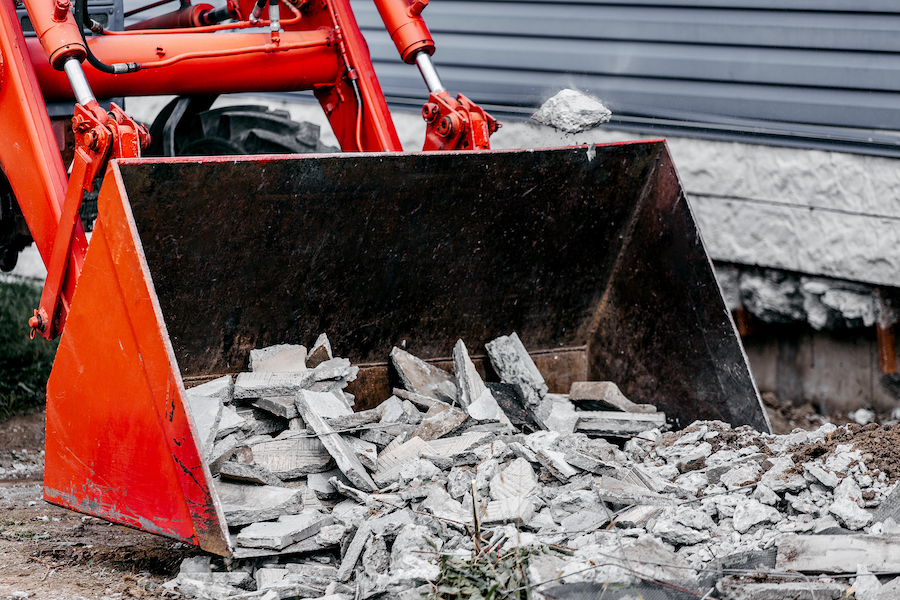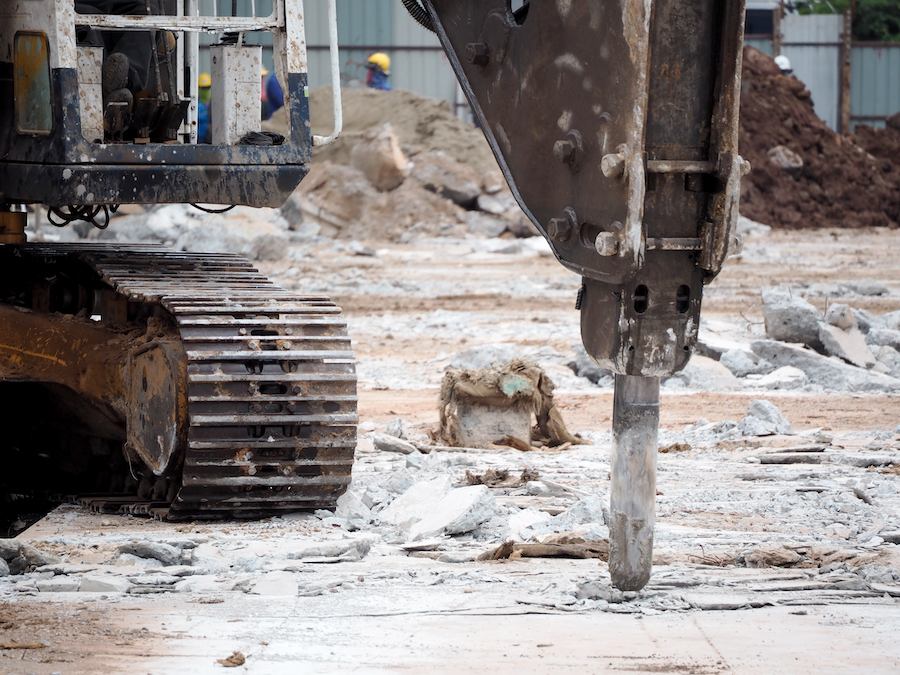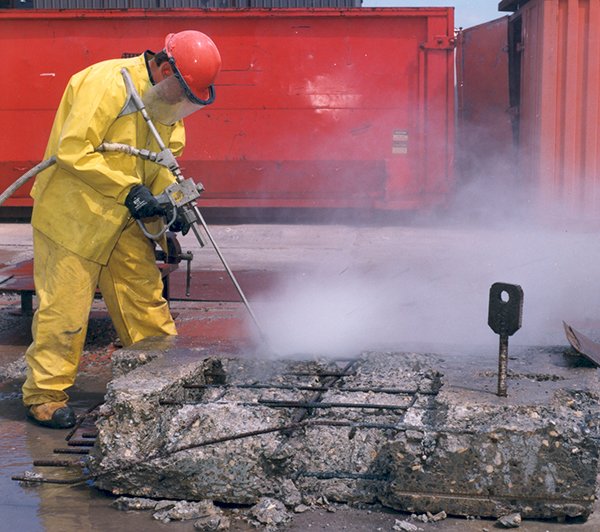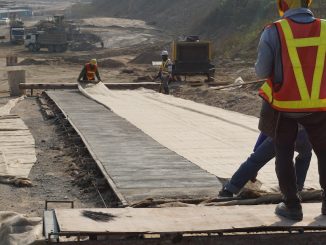
View the complete article here.
There are several situations where concrete needs to be removed. Whether the project is big – such as widening an existing road – or small – like removing a damaged patio – you need a plan. In this article we discuss methods for properly removing concrete. So set that jackhammer aside and let’s walk through the details of a concrete removal project.
Patch or Remove?
The first decision you’ll need to make is whether the concrete needs to be removed. There are situations where patching or resurfacing will fix the problem – at least in the short term. One example is getting a home ready for sale. If repairing the concrete can address any safety and aesthetic issues, that costs less in time and hard cash than a total replacement. Here are situations where repairing the concrete is just a waste because it won’t last long enough to be worth the expense:
- Settlement that has caused numerous, deep cracks.
- Sunken concrete. This is often a sign of a poorly prepared sub grade.
- Frost heave. This occurs in cold climates where the concrete pushes upward over time from the freezing and refreezing of the moisture under the concrete.
- Excessive spalling or pitting the concrete’s surface.

Concrete Removal Methods
For small jobs, like a residential patio, you just need a few tools, some plastic sheeting, personal protection equipment (PPE), a wheelbarrow, and a strong back. You have several options for larger concrete removal jobs, including pressure bursting, pneumatic and hydraulic breakers, jackhammers, and dismantling.
Small Jobs
After donning your PPE, use plastic sheeting to cover the concrete. This is only required if you will be breaking up the concrete near windows. You’ll use a sledgehammer for a concrete slab less than 4-inches thick. Four inches and thicker slabs will require a demolition hammer. The steps for removing small amounts of concrete are:
- Dig under the concrete if possible.
- Begin breaking up the concrete about half a foot from the edge of the concrete. Work your way toward the center of the slab.
- Use a long bar or wrecking bar to pry the concrete up as you’re breaking. A fulcrum placed under the bar will provide greater leverage.
- Use bolt cutters to cut mesh wire. Rebar will require a metal blade or cutoff wheel to remove.
- Use a wheelbarrow to move the rubble to a flatbed truck or other vehicle capable of towing the load.
- Dispose of the concrete following any local laws. Some waste services company may pick it up. Or you may need to bring it to a dump where they may charge a fee.
Larger Jobs
There are several methods for breaking up larger concrete structures such as pavement, bridge decks, and foundations.
Pressure Bursting
The pressure bursting method of concrete removal results in minimal noise and flying debris. Amazingly, this method is virtually silent. It is a great solution when removing concrete in high-density areas or where other nearby structures need to remain standing. There are two different types of pressure bursting methods: mechanical and chemical.
Mechanical
With mechanical bursting, holes are pre-drilled into the cement. Hydraulic burster heads are placed inside the holes. They are expanded mechanically – which produces pressure that ultimately causes the cement to split and crack. This results in smaller pieces that are more readily removed. The larger the hydraulic burster heads, the more pressure they apply to the cement. The size and number of the pre-drilled holes depends on the size of the structure and the thickness of the concrete.
Chemical
Chemical bursting also requires pre-drilling holes into the concrete. However, instead of mechanical heads being placed into the holes, a slurry is poured into the them. These special mixes expand and break up the concrete. It takes anywhere from a few hours to as long as a day for the slurry to work its magic. Once the concrete is broken down, it can be removed either manually or with a crane.

Pneumatic and Hydraulic Breakers
Pneumatic and hydraulic breakers (sometimes referred to as percussion hammers) are attachments that can be mounted on various types of equipment – such as backhoes, excavators, and skid steers. Hydraulic breakers are often used in road construction. In addition to boom-mounted breakers, handheld breakers may also be used. A telescoping boom provides additional reach and better maneuverability in tight spaces. A downside of boom-mounted breakers is that they generate a lot of noise, vibration, and dust. However, they can be used for underwater demolition. And operating a breaker remotely is an option for machine-mounted breakers.
Jackhammer
Jackhammers can be handheld or rig mounted. They can be powered by electricity, air compressors (pneumatic), or hydraulics. They are noisy and generate a lot of dust and vibration. In fact, it’s the vibration that can cause physical problems for those workers who operate them for extended periods of time. If you choose to use a handheld jackhammer, limit the amount of time you use it. Ear protection is an absolute necessity, along with headgear, steel-toed boots, and eye protection. Breaking up concrete walls will require a rig mounted jackhammer. Unless you’re The Hulk, you won’t be able to lift a jackhammer while it’s running.
Dismantling
Dismantling concrete involves breaking down the structure into smaller pieces then removing them by crane. There are generally three ways to reduce the concrete down to size: sawing, water-jetting, and thermic lace. The dismantling method of concrete removal minimizes dust and noise. It also has less of an impact on nearby structures.
Sawing
You can cut through concrete with a circular saw and a special blade. There are a few options including Abrasive corundum masonry blades, dry-cutting diamond blades, and wet-cutting diamond blades. A dry-cutting diamond blade can be used dry or wet. You must use water when using a wet-cutting diamond blade.
Water-jetting
Water-jetting involves using a high-flow, high-pressure stream of water, along with an abrasive, to cut through cement. You can also remove coatings from cement that you want to keep in place by using a lower flow jet stream without an abrasive.

Thermic lance
A thermic lance removes concrete and any rebar or wire mesh within it by melting it. It uses pure oxygen passed through a pipe that is lit with an oxy-acetylene torch or other high-temperature source. The resulting heat and liquid slag that splashes out can cut through any substance. At about 4000 degrees Celsius, it makes mincemeat of concrete – which has a melting point between 1800 and 2500 degrees Celsius. Steel melts at under 1500 degrees Celsius. A thermic lance can cut concrete and other materials underwater.
Additional Costs for Concrete Removal
When planning your concrete removal project, remember to include some additional costs in your budget, including:
- Demolition Permit
- Encroachment Permit
- Inspection Services
Minimally, you want to talk to your local utility company to ensure that you don’t damage buried pipes.
Safety Tips
- Inspect your PPE before you begin work. Proper boots, safety glasses, ear plugs, face masks, and gloves should be considered mandatory.
- Do not wear loose clothing that can be sucked into machinery.
- It is best to leave your jewelry at home. Rings, bracelets, and earrings can get in the way.
- If you have long hair, tie it back tightly. Long hair can get caught up in machinery, but it can also block your vision.
- Anyone not directly involved in removing the concrete should be cleared from the area.
- Be heads up! You’re working with some serious equipment. If you’re too tired or distracted, someone is going to get hurt.
Conclusion
There are many options for removing concrete. Choose methods that are right for the size and location of the job – as well as the expertise required. Be sure you have the proper permits, if needed. Budget for other expenses such as inspections and dumping fees. Always inspect your PPE before you begin work. You may think you can get one more day out of those boots, but if they look worn, don’t risk it. Proper planning will ensure a safe and effective concrete removal job.
View the complete article here.
When should concrete be patched or repaired instead of completely removed?
oncrete can be patched or repaired for short-term fixes, but total removal is necessary for issues like settlement causing deep cracks, sunken concrete, frost heave, or excessive spalling and pitting.
What are the different methods for removing concrete, and how do they vary?
Concrete removal methods include small-scale options like using a sledgehammer for residential patios and larger methods like pressure bursting (mechanical and chemical), pneumatic/hydraulic breakers, jackhammers, and dismantling; each method suits different project sizes and requirements.













































